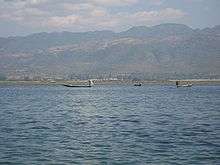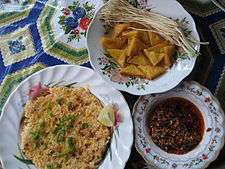Inle Lake
| Inle Lake | |
|---|---|
|
| |
| Location | Shan State |
| Coordinates | 20°33′N 96°55′E / 20.550°N 96.917°ECoordinates: 20°33′N 96°55′E / 20.550°N 96.917°E |
| Type | Polymictic lake |
| Primary outflows | Nam Pilu |
| Basin countries | Myanmar |
| Surface area | 44.9 sq mi (116 km2) |
| Average depth | 5 ft (1.5 m) (dry season) |
| Max. depth | 12 ft (3.7 m) (dry season; +5 ft in monsoon season) |
| Surface elevation | 2,900 ft (880 m) |

Inle Lake (Burmese: အင်းလေးကန်, pronounced: [ʔɪ́ɴlé kàɴ]), also known as Inle Sap, is a freshwater lake located in the Nyaungshwe Township of Taunggyi District of Shan State, part of Shan Hills in Myanmar (Burma). It is the second largest lake in Myanmar with an estimated surface area of 44.9 square miles (116 km2), and one of the highest at an elevation of 2,900 feet (880 m). During the dry season, the average water depth is 7 feet (2.1 m), with the deepest point being 12 feet (3.7 m), but during the rainy season this can increase by 5 feet (1.5 m).
The watershed area for the lake lies to a large extent to the north and west of the lake. The lake drains through the Nam Pilu or Balu Chaung on its southern end. There is a hot spring on its northwestern shore.
Although the lake is not large, it contains a number of endemic species. Over twenty species of snails and nine species of fish are found nowhere else in the world. Some of these, like the silver-blue scaleless Sawbwa barb, the crossbanded dwarf danio, and the Lake Inle danio, are of minor commercial importance for the aquarium trade. It hosts approximately 20,000 brown and black head migratory seagulls in November, December and January.[1]
In June 2015, it became Myanmar's first designated place of World Network of Biosphere Reserves.[2] It was one of 20 places added at at the Unesco's 27th Man and the Biosphere (MAB) International Coordinating Council (ICC) meeting.[3]
People and culture

The people of Inle Lake (called Intha), some 70,000 of them, live in four cities bordering the lake, in numerous small villages along the lake's shores, and on the lake itself. The entire lake area is in Nyaung Shwe township. The population consists predominantly of Intha, with a mix of other Shan, Taungyo, Pa-O (Taungthu), Danu, Kayah, Danaw and Bamar ethnicities. Most are devout Buddhists, and live in simple houses of wood and woven bamboo on stilts; they are largely self-sufficient farmers.
Most transportation on the lake is traditionally by small boats, or by somewhat larger boats fitted with single cylinder inboard diesel engines. Local fishermen are known for practicing a distinctive rowing style which involves standing at the stern on one leg and wrapping the other leg around the oar. This unique style evolved for the reason that the lake is covered by reeds and floating plants making it difficult to see above them while sitting. Standing provides the rower with a view beyond the reeds. However, the leg rowing style is only practiced by the men. Women row in the customary style, using the oar with their hands, sitting cross legged at the stern.

Fish caught from the lake - the most abundant kind is called nga hpein locally (Inle carp, Cyprinus intha) - are a staple of the local diet. A popular local dish is htamin gyin - 'fermented' rice kneaded with fish and/or potato - served with hnapyan gyaw (literally twice fried - Shan tofu). In addition to fishing, locals grow vegetables and fruit in large gardens that float on the surface of the lake. The floating garden beds are formed by extensive manual labor. The farmers gather up lake-bottom weeds from the deeper parts of the lake, bring them back in boats and make them into floating beds in their garden areas, anchored by bamboo poles. These gardens rise and fall with changes in the water level, and so are resistant to flooding. The constant availability of nutrient-laden water results in these gardens being incredibly fertile. Rice cultivation is also significant.
Hand-made goods for local use and trading are another source of commerce. Typical products include tools, carvings and other ornamental objects, textiles, and cheroots. A local market serves most common shopping needs and is held daily but the location of the event rotates through five different sites around the lake area, thus each of them hosting an itinerant market every fifth day.[4] When held on the lake itself, trading is conducted from small boats. This 'floating-market' event tends to emphasize tourist trade much more than the other four.
The Inle lake area is renowned for its weaving industry. The Shan-bags, used daily by many Burmese as a tote-bag, are produced in large quantities here. Silk-weaving is another very important industry, producing high-quality hand-woven silk fabrics of distinctive design called Inle longyi. A unique fabric from the lotus plant fibers is produced only at Inle lake and is used for weaving special robes for Buddha images called kya thingahn (lotus robe).[5]
Environmental concerns
Inle Lake is suffering from the environmental effects of increased population and rapid growth in both agriculture and tourism. During the 65-year period from 1935 to 2000, the net open water area of Inle Lake decreased from 69.10 km² to 46.69 km², a loss of 32.4%, with development of floating garden agriculture, which occurs largely on the west side of the lake (a practice introduced in the 1960s).[6]
Lumber removal and unsustainable cultivation practices (slash and burn farming techniques) on the hills surrounding the lake are causing ever-increasing amounts of silt and nutrients to run off into the rivers that feed the lake, especially along its western and northern watershed areas. This silt fills up the lake; the nutrients encourage the growth of weeds and algae. More important however is the development of floating garden agriculture, largely along the western side of the lake. This practice encroaches into the diminishing area of the lake, since over time, the floating beds become solid ground. About 93% (nearly 21 km²) of the recent loss in open water area of the lake, largely along its western side, is thought to be due to this agricultural practice. Direct environmental impacts associated with these combined agricultural activities within the wetlands and surrounding hills of the lake include sedimentation, eutrophication, and pollution.[6]
The water hyacinth, a plant not native to the lake, also poses a major problem. It grows rapidly, filling up the smaller streams and large expanses of the lake, robbing native plants and animals of nutrients and sunlight. At one time, all boats coming into Nyaung Shwe were required to bring in a specified amount of water hyacinth. Over the past twenty years, large-scale use of dredges and pumps has been employed with some success in controlling the growth of this plant. On a smaller scale, public awareness education and small-scale control have also been successful.
Another cause for concern is the planned introduction of non-native fish species, such as the Grass Carp (Ctenopharyngodon idella)] intended to improve fishery.
Sanitation in the villages around the lake is an ongoing concern for public health authorities, due to untreated sewage (with 72% of households using open pits, not latrines) and waste water flowing into the lake.[7] To ensure fresh and clean water, some villages now have enclosed wells and public access to the well water. Some studies of the lake's surface water quality indicates that the water is not safe for consumption.[7] Water from Inle Lake has dissolved oxygen ranges lower than those necessary for fisheries and aquatic life, while nitrite, nitrate and phosphate ranges are unusually high.[7]
Noise pollution is also a noticeable issue. The noise from the cheaper poorly muffled diesel engines driving the stern drive propellers is significant, and can be a distraction to the otherwise tranquil lake.
The summer of 2010 registered very high temperatures causing the water level of the lake to drop so low, the lowest in nearly 50 years, that drinking water had to be fetched from elsewhere and the floating market was in danger of disappearing.[8] One other serious consequence was that the hydroelectric plant at Lawpita, where the former capital Yangon received its power supply from, could not operate at its full capacity.[9]
Tourism
The best time of the year to visit is during September and October. The ceremonial Hpaung Daw U Festival, which lasts for almost three weeks, is closely followed by the Thadingyut festival of lights. Inthas and Shan turn out in their best clothes in great numbers to celebrate the Buddhist Lent. Traditional boat racing, with dozens of leg-rowers in Shan dress in a team on each boat, is a famous event during the Hpaung Daw U Festival.
Inle Lake is a major tourist attraction, and this has led to some development of tourist infrastructure. Many small and large privately owned hotels and tour operations have arisen during the past few years. Local shops are flooded with consumer items, both local and foreign. The nearest airport is Heho Airport which is 35 km away. There are flights from both Yangon and Mandalay. Yangon is 660 km away by road, Mandalay 330 km.
Cuisine
Inle cuisine is different from Shan cuisine, as it incorporates local natural produce. The most well-known Inle dish would be the Htamin jin - a rice, tomato and potato or fish salad kneaded into round balls dressed and garnished with crisp fried onion in oil, tamarind sauce, coriander and spring onions often with garlic, Chinese chives roots (ju myit), fried whole dried chili, grilled dried fermented beancakes (pè bouk) and fried dried tofu (topu jauk kyaw) on the side.
See also
References
- ↑ http://www.mrtv3.net.mm/newpaper/2511newsn.pdf Page 16 Col 1
- ↑ Aye Sapay Phyu. "Inle Lake joins UN list of biosphere sites". http://www.mmtimes.com/. Retrieved 19 June 2015. External link in
|website=(help) - ↑ "Inle Lake designated biosphere reserve". http://www.nationmultimedia.com/. Retrieved 19 June 2015. External link in
|website=(help) - ↑ "Fifth day markets". JourneysMyanmar. Retrieved 2007-02-19.
- ↑ "The Elegant and Sacred Lotus Robe". Myanmar Travel Information. 2006. Archived from the original on 2006-12-18. Retrieved 2007-02-18.
- 1 2 Roy C. Sidle, Alan D. Ziegler and John B. Vogler (April 2007). "Contemporary changes in open water surface area of Lake Inle, Myanmar". Sustainability Science. 2 (1): 55–65. doi:10.1007/s11625-006-0020-7. ISSN 1862-4065. Retrieved 22 June 2010.
- 1 2 3 Fumiko, Akaishi; Motoyoshi Satake; Masahiro Otaki; Noriko Tominaga (13 April 2006). "Surface water quality and information about the environment surrounding Inle Lake in Myanmar" (PDF). Limnology. Japanese Society of Limnology: 57–61.
- ↑ Ko Htwe. "Electricity for Businesses Cut Off in Rangoon". The Irrawaddy, May 17, 2010. Retrieved 2010-05-17.
- ↑ Ba Kaung. "Businesses May Close Because of Power Cuts". The Irrawaddy, May 21, 2010. Retrieved 2010-05-29.
External links
| Wikimedia Commons has media related to Inle Lake. |
| Wikivoyage has a travel guide for Inle Lake. |
- Inle lake tourism
- Images from Inle Lake
- Large scale manufacture of Shan tofu at Inle Lake video
- Inle Lake moving postcards
- Inle Lake in Photos